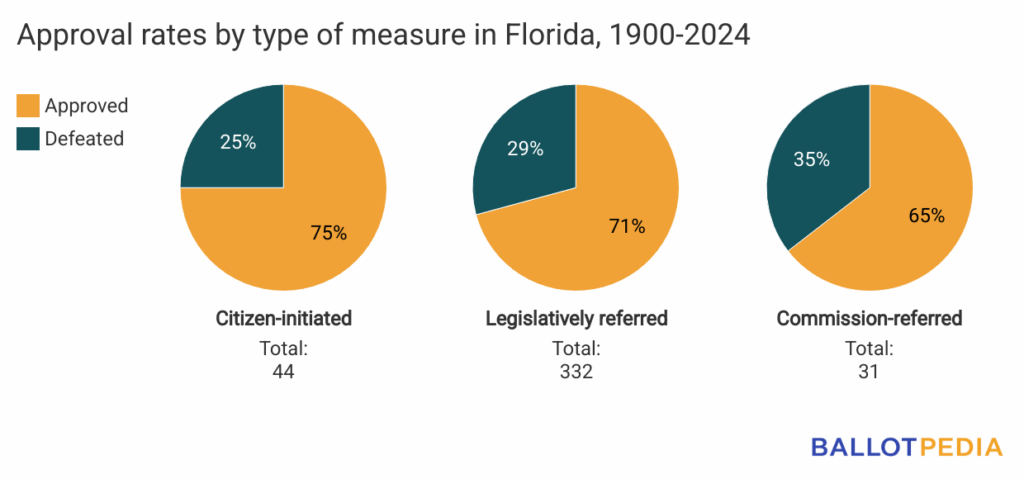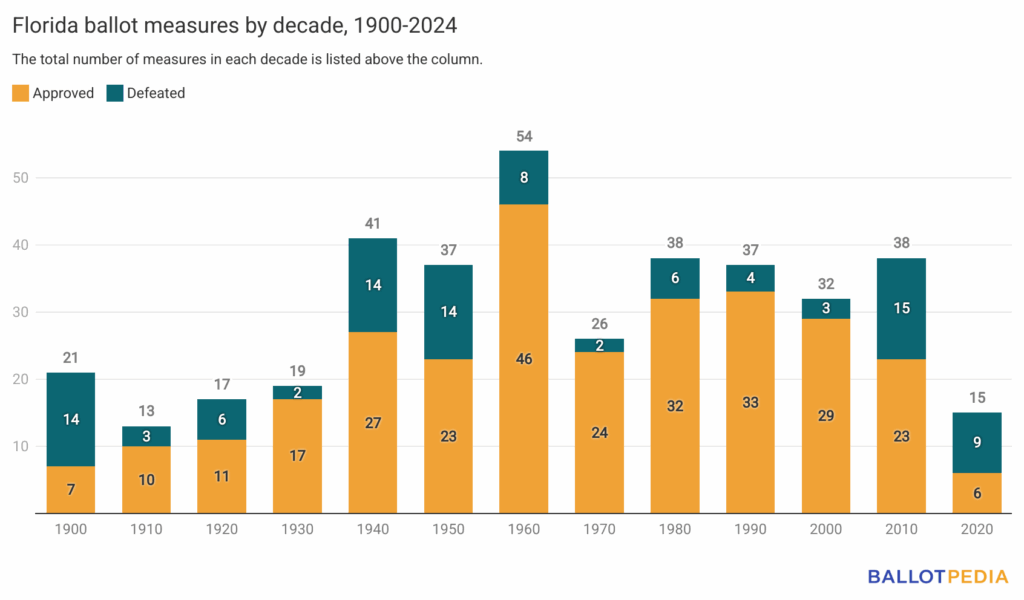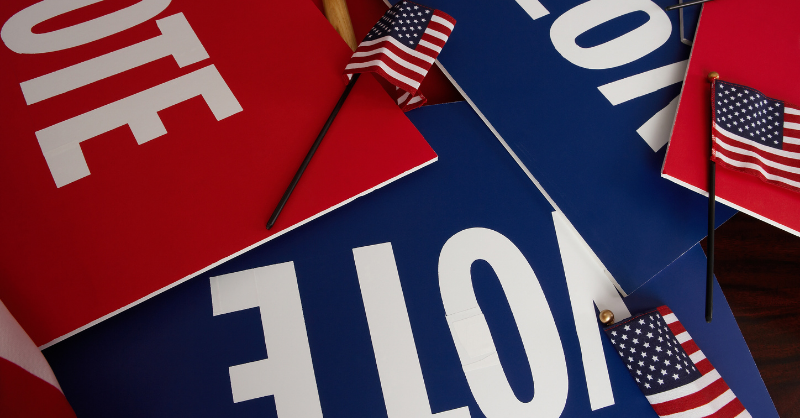Since 1900, Florida voters have decided on 407 ballot measures—approving 288 (71%) and rejecting 119 (29%).
There are five different types of ballot measures in Florida. Legislatively referred constitutional amendments have appeared on the ballot the most number of times (327), with voters approving 70% of them. Initiatives have appeared on statewide ballots 44 times and have had the best success rate, with 33 of the 44 approved. Florida is also the only state with commissions empowered to refer constitutional amendments to the ballot. The Florida Constitution Revision Commission (FCRC) and the Florida Taxation and Budget Reform Commission (TBRC) have referred 31 amendments to the ballot, with 20 approved and 11 defeated.

Florida ballot measures have addressed 140 unique topics, with some addressing multiple topics in one measure. Below is a selection of notable and unique ballot measures in Florida’s history. For a more detailed list, see here.
- With the adoption of the 1968 constitution, voters also created the Florida Constitution Revision Commission. The commission is tasked with examining the constitution, holding public hearings, and referring constitutional amendments to the ballot no later than 180 days before an election.
- Voters defeated a measure to abolish the commission in 1980, with 57% of voters opposing the measure.
- In 1996, voters approved an amendment to move the next meeting of the Constitution Revision Commission to 1997 and allow the Commission to review matters relating to taxation or the state budgetary process.
- In 2022, voters defeated a legislatively referred constitutional amendment that would have abolished the state Constitution Revision Commission. It needed 60% of the vote to pass, but received 54%.
- Florida voters created the Taxation and Budget Reform Commission, which is authorized to refer amendments to the ballot, with the approval of Amendment 6 in 1988, requiring the commission to meet in 1990 and every 10 years after. In 1998, voters approved an amendment proposed by the Florida Constitution Revision Commission that changed the meeting schedule from every 10 years to every 20 years.
- Florida adopted its first supermajority requirement in 1996 when it approved Amendment 1 to require new state taxes and fees to be approved by a two-thirds vote. A 60% supermajority requirement was adopted for all constitutional amendments with the approval of Amendment 3 in 2006.
- Florida voters have decided on four legislatively referred advisory questions.
- In 1972, voters approved three nonbinding questions demonstrating their support for passing a federal ban to prohibit forced busing; providing "equal opportunity for quality education for all children" regardless of race, creed, color, or place of residence; and passing an amendment to the U.S. Constitution to allow prayer in public schools. All received at least 74% of the vote.
- In 2010, voters approved a nonbinding question showing support for an amendment to the U.S. Constitution to require that the federal budget be balanced without raising taxes. It received support from 72% of voters.
- Florida voters adopted Amendment 11 in 1998, which provided for public campaign financing for statewide offices. The amendment was approved with 64.12% of voters in favor and 35.88% opposed. Voters considered two amendments to repeal the public financing provisions in 2010 and 2024, but neither received 60% of the vote to be adopted.
- In 2024, Florida voters defeated an amendment that would have added the following language to the state's Declaration of Rights: "… no law shall prohibit, penalize, delay, or restrict abortion before viability or when necessary to protect the patient’s health, as determined by the patient’s healthcare provider.” The margin was 57% in favor to 43% opposed.
The measure with the closest margin was Florida Amendment 10 in 1988, which was defeated by a margin of 49.83% supporting it to 50.17% opposing it. It would have established and expanded tax exemptions for municipal and local property. The measure with the widest margin was approved in 1936 with 92% of voters supporting it. The amendment allowed the state to create and fund a uniform statewide public assistance system for residents who, "age, infirmity, or misfortune, may have claims upon the aid and sympathy of society."
The average number of measures per decade was 31, and the average number of measures approved per decade was 69%. The decade with the most ballot measures was the 1960s, which featured 54 ballot measures. Forty-six ballot measures (86%) were approved, and eight measures (14%) were defeated. The decade with the highest approval rate was the 2000s, which featured 32 ballot measures, with all but three approved. The decade with the lowest approval rating was the 1900s, which saw only seven of the 21 ballot measures approved.

The inventory of Florida statewide ballot measures is part of Ballotpedia's Historical Ballot Measure Factbook, which will document nearly 200 years of direct democracy in the United States. This ongoing research effort will provide an unparalleled resource for researchers, reporters, and the voting public on how ballot measures have evolved, the issues they've covered, and the role they have played in our civic life.


